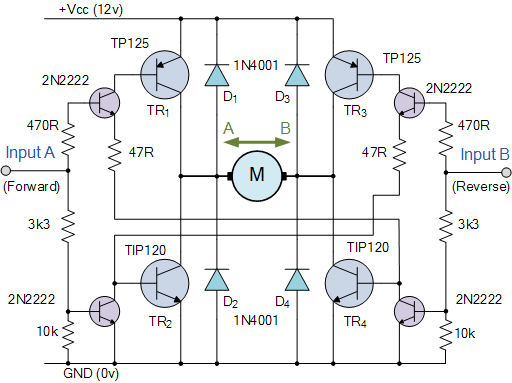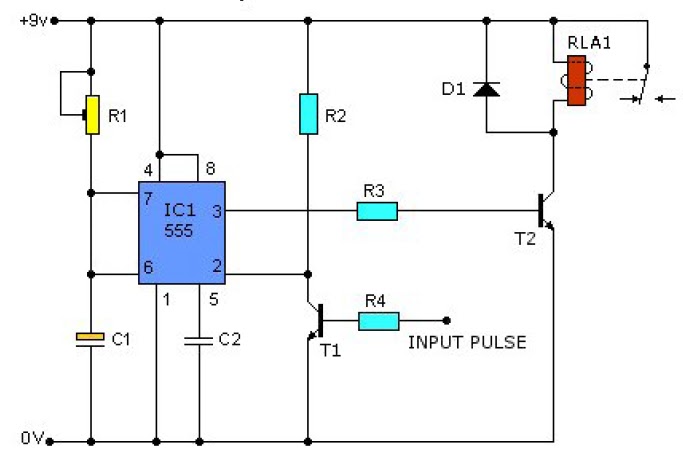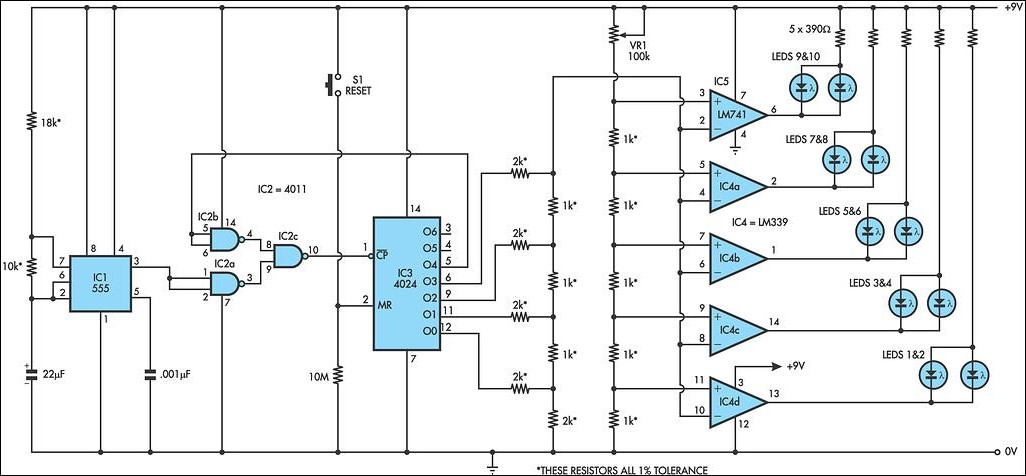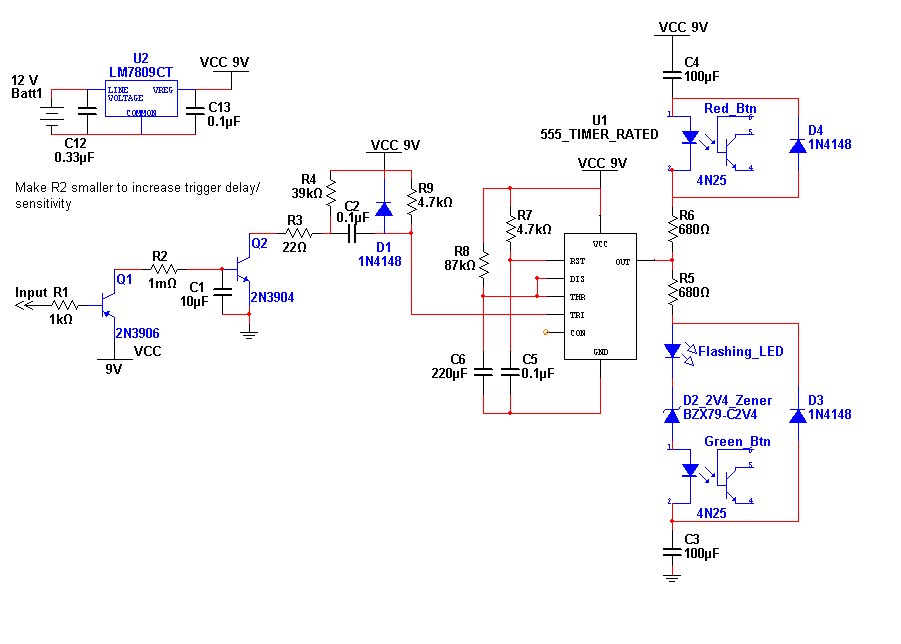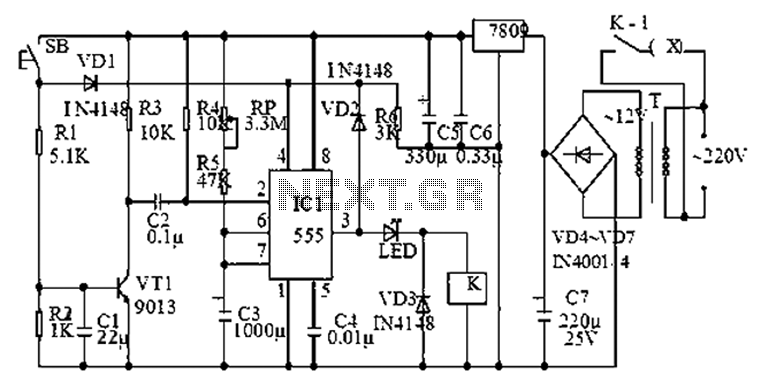
How To Use A Cmos 4017 To Build A Sequential Timer
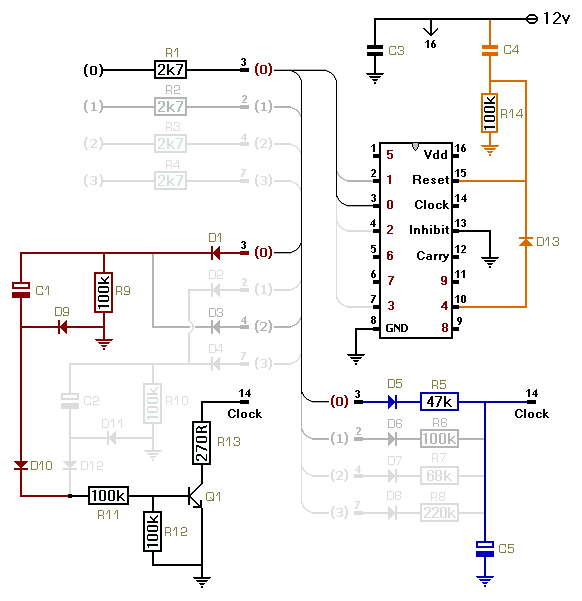
This circuit utilizes a CMOS 4017 decade counter, which begins counting from zero and increments by one each time pin 14 is activated. Upon reaching a count of nine, it resets to zero and starts the counting process again. As the count progresses, each output pin activates sequentially, starting with pin 3, which represents zero, followed by pin 2 for one, pin 4 for two, and so forth. Although the 4017 can count up to nine, this circuit is designed to count only up to four, resulting in some output pins remaining unconnected, which is advisable for unused CMOS output pins. The circuit employs the first five outputs: pins 3, 2, 4, 7, and 10. Each of these output pins is linked to a 2.7kΩ resistor, limiting the current when powered by a 12V supply to just under 5mA, sufficient for operating a transistor switch, which can activate a buzzer or relay. Increasing the output current to around 10mA would require reducing the resistor value, with a guideline suggesting that the resistor should not fall below 1kΩ. Each step in the sequence involves charging capacitor C5 through a timing resistor, and when the voltage on C5 raises pin 14 high, the sequence advances to the next output. Initially, when power is turned on, the count starts at zero, activating pin 3 while the other output pins remain low. Pin 3 serves three functions: supplying output current through R1, rapidly discharging C5 through R13 and Q1, and slowly recharging C5 through D5 and R5. While C5 does not need to be discharged at power-up, it must be discharged at the start of each subsequent sequence event. Advancing the count to one requires pin 14 to be activated. A CMOS input pin is considered high when it exceeds half the supply voltage. As pin 3 charges C5, the voltage on pin 14 rises, and when it reaches approximately 6.5V, the counter moves to one, initiating the second sequence event where pin 2 provides the output current, discharges C5 through R13 and Q1, and begins recharging C5 through D6 and R6. The act of raising pin 14 high triggers the timer to advance to the next step, but pin 14 cannot be activated if it is already high, necessitating the discharge of C5 at the start of each sequence step. This discharge is performed by Q1, which rapidly discharges the capacitor through R13 when switched on. Directly using pin 3 to provide base current to the transistor is not feasible, as it would keep Q1 permanently activated, preventing pin 14 from rising and halting the sequence. Instead, pin 3 is designed to briefly supply base current to Q1, allowing for C5 to discharge and subsequently switch off while R5 recharges the capacitor. This is accomplished by connecting a capacitor (C1) between the output pin and the base of Q1. When pin 3 activates, C1 is initially discharged and will take about 10 seconds to charge through resistors R11 and R12. During this charging period, C1 supplies base current to Q1, turning it on. Once C1 reaches full charge, the base current ceases, and the transistor will switch off.
The CMOS 4017 decade counter is a versatile component used in various timing and counting applications. This circuit specifically leverages its ability to sequentially activate output pins, which can be utilized in applications such as LED chasers, sound generation, or control of relay-based systems. The design incorporates essential components such as resistors, capacitors, and a transistor to control the timing and current levels effectively. The use of a timing capacitor (C5) allows for controlled sequencing, ensuring that each output pin is activated in a timely manner, which is crucial for applications requiring precise timing sequences.
In terms of implementation, the circuit should be built on a breadboard or PCB, ensuring that all connections are secure and that the power supply is stable. The transistor (Q1) should be selected based on the required current handling capacity for the load being driven, whether it be a relay or a buzzer. The choice of resistors (R1, R5, R11, R12, and R13) should be calculated based on the desired current levels and timing requirements, ensuring that the values are suitable for the operation of the CMOS 4017 and the associated components.
In conclusion, this circuit design effectively demonstrates the use of a CMOS 4017 decade counter for counting applications, highlighting the importance of component selection and timing control in electronic circuits. Proper implementation will yield a reliable and functional counting circuit suitable for various applications.This circuit uses a Cmos 4017. The 4017 is a decade counter. The count starts at zero. And it advances by one - each time pin 14 is taken high. When the count reaches nine - it goes back to zero - and starts all over again. = As the count progresses - each of the output pins goes high in turn. The first is pin 3 - it represents zero. The second is pin 2 - it represents one. Pin 4 represents two - and so on. The number represented by each output pin is shown in red. = Although the 4017 will count up to nine - we are only using it to count up to four. Consequently - some of the output pins are unused. Unused Cmos output pins should always be left unconnected. = The circuit uses the first five outputs. These are - pins 3, 2, 4, 7 & 10 The first four outputs pins are each connected to a 2k7 resistor. With a 12v supply - the resistor limits the current available to 12v G· 2k7 = just under 5mA. = This is more than enough to operate a transistor switch. And the transistor can be used to sound a buzzer - or energize a relay. If you increase the current to about 10mA - it will drive an optical isolator. = To increase the current - you should reduce the value of the resistor. As a rough guide - it`s safe to draw up to about 1mA per supply volt. This means that the value of the resistor - should never be below 1k. = Every step in the sequence is the same. Each output charges C5 through a timing resistor. And - when the voltage on C5 takes pin 14 high - the sequence moves on to the next output. For clarity - I`ve only highlighted the first step in the sequence. Once you understand the first step - you`ll understand the remaining three steps as well. = Consider what happens when we turn on the power. The count begins at zero. In other words - pin 3 will be high. And the rest of the output pins will be low. = Pin 3 does three different jobs. It provides the necessary output current - through R1. It discharges C5 rapidly - through R13 & Q1. And it recharges C5 slowly - through D5 & R5. = It`s true that - at power up - C5 doesn`t need discharging. But it does have to be discharged at the start of every subsequent event in the sequence. = For the count to advance to one - pin 14 must be taken high. A Cmos input pin is high when it`s just over half the value of the supply voltage. As pin 3 charges C5 - the voltage on pin 14 rises. When it reaches roughly 6v5 - the counter will advance to one. And the second event in the sequence will commence. = That is - pin 2 will supply the necessary output current. It will also discharge C5 rapidly - through R13 & Q1. And it will begin the process of taking pin 14 high again - by recharging C5 - through D6 & R6. = It`s the act of taking pin 14 high - that causes the timer to advance to the next step in the sequence. But pin 14 can`t be taken high - if it`s already high. That`s why - at the beginning of each step in the sequence - C5 must be discharged. = The job of discharging C5 is carried out by Q1. When the transistor switches on - it discharges the capacitor rapidly - through R13. = We can`t simply use pin 3 to supply base current to the transistor. If we did - Q1 would remain permanently switched on. As a result - the transistor would hold pin 14 permanently low. Consequently - C5 would never charge - and the sequence would never progress. = When pin 3 goes high - we only want it to supply base current to the transistor for a short period.
We want Q1 to switch on - discharge C5 - and then switch off again. Thus leaving R5 free to recharge the capacitor. = We can achieve this by connecting a capacitor between the output pin and the base of Q1. When pin 3 goes high - C1 is in a discharged state. It will take about 10 seconds or so to charge - through R11 & R12. But while it`s charging - it will supply base current to Q1. And the transistor will switch on. = Once C1 is fully charged - the base current will cease. And the transistor will switc 🔗 External reference
The CMOS 4017 decade counter is a versatile component used in various timing and counting applications. This circuit specifically leverages its ability to sequentially activate output pins, which can be utilized in applications such as LED chasers, sound generation, or control of relay-based systems. The design incorporates essential components such as resistors, capacitors, and a transistor to control the timing and current levels effectively. The use of a timing capacitor (C5) allows for controlled sequencing, ensuring that each output pin is activated in a timely manner, which is crucial for applications requiring precise timing sequences.
In terms of implementation, the circuit should be built on a breadboard or PCB, ensuring that all connections are secure and that the power supply is stable. The transistor (Q1) should be selected based on the required current handling capacity for the load being driven, whether it be a relay or a buzzer. The choice of resistors (R1, R5, R11, R12, and R13) should be calculated based on the desired current levels and timing requirements, ensuring that the values are suitable for the operation of the CMOS 4017 and the associated components.
In conclusion, this circuit design effectively demonstrates the use of a CMOS 4017 decade counter for counting applications, highlighting the importance of component selection and timing control in electronic circuits. Proper implementation will yield a reliable and functional counting circuit suitable for various applications.This circuit uses a Cmos 4017. The 4017 is a decade counter. The count starts at zero. And it advances by one - each time pin 14 is taken high. When the count reaches nine - it goes back to zero - and starts all over again. = As the count progresses - each of the output pins goes high in turn. The first is pin 3 - it represents zero. The second is pin 2 - it represents one. Pin 4 represents two - and so on. The number represented by each output pin is shown in red. = Although the 4017 will count up to nine - we are only using it to count up to four. Consequently - some of the output pins are unused. Unused Cmos output pins should always be left unconnected. = The circuit uses the first five outputs. These are - pins 3, 2, 4, 7 & 10 The first four outputs pins are each connected to a 2k7 resistor. With a 12v supply - the resistor limits the current available to 12v G· 2k7 = just under 5mA. = This is more than enough to operate a transistor switch. And the transistor can be used to sound a buzzer - or energize a relay. If you increase the current to about 10mA - it will drive an optical isolator. = To increase the current - you should reduce the value of the resistor. As a rough guide - it`s safe to draw up to about 1mA per supply volt. This means that the value of the resistor - should never be below 1k. = Every step in the sequence is the same. Each output charges C5 through a timing resistor. And - when the voltage on C5 takes pin 14 high - the sequence moves on to the next output. For clarity - I`ve only highlighted the first step in the sequence. Once you understand the first step - you`ll understand the remaining three steps as well. = Consider what happens when we turn on the power. The count begins at zero. In other words - pin 3 will be high. And the rest of the output pins will be low. = Pin 3 does three different jobs. It provides the necessary output current - through R1. It discharges C5 rapidly - through R13 & Q1. And it recharges C5 slowly - through D5 & R5. = It`s true that - at power up - C5 doesn`t need discharging. But it does have to be discharged at the start of every subsequent event in the sequence. = For the count to advance to one - pin 14 must be taken high. A Cmos input pin is high when it`s just over half the value of the supply voltage. As pin 3 charges C5 - the voltage on pin 14 rises. When it reaches roughly 6v5 - the counter will advance to one. And the second event in the sequence will commence. = That is - pin 2 will supply the necessary output current. It will also discharge C5 rapidly - through R13 & Q1. And it will begin the process of taking pin 14 high again - by recharging C5 - through D6 & R6. = It`s the act of taking pin 14 high - that causes the timer to advance to the next step in the sequence. But pin 14 can`t be taken high - if it`s already high. That`s why - at the beginning of each step in the sequence - C5 must be discharged. = The job of discharging C5 is carried out by Q1. When the transistor switches on - it discharges the capacitor rapidly - through R13. = We can`t simply use pin 3 to supply base current to the transistor. If we did - Q1 would remain permanently switched on. As a result - the transistor would hold pin 14 permanently low. Consequently - C5 would never charge - and the sequence would never progress. = When pin 3 goes high - we only want it to supply base current to the transistor for a short period.
We want Q1 to switch on - discharge C5 - and then switch off again. Thus leaving R5 free to recharge the capacitor. = We can achieve this by connecting a capacitor between the output pin and the base of Q1. When pin 3 goes high - C1 is in a discharged state. It will take about 10 seconds or so to charge - through R11 & R12. But while it`s charging - it will supply base current to Q1. And the transistor will switch on. = Once C1 is fully charged - the base current will cease. And the transistor will switc 🔗 External reference
